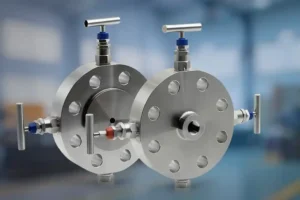Process measurement and control employs a wide array of gauges and instruments that may be permanently or temporarily connected to a piping system. Providing controlled isolation and connection of these instruments is the function of what is generically referred to as “instrument valves” or “gauge valves”. These valves are generally small, with connection sizes ranging from 1/8″ to 1″, though there are specialty variants outside this range. The predominant valve type is a needle valve, but ball valves and some other types are also used. Certain attributes of particular applications may weigh a selection decision toward a valve type. Widely used throughout the process industries, instrument valves are often designed to accommodate pressures as high as 6000 PSI and are intended for service with gaseous or liquid service.
When selecting instrumentation valve suppliers, consider construction materials that are compatible with the process media. Ball valves in this class do not provide the throttling accuracy of a needle valve but may provide some advantage with the use of certain media. The ball valve design, with its full-size port, enables easier cleaning and a lessened potential for clogging.
Configurations of Instrumental Valves
There are three basic configurations of instrumentation valves:
- The easiest is the isolation valve that has a single inlet and outlet. This is to provide a selection of exposure or isolation of a connected gauge or other devices to the operating process piping or vessel. Maintenance or replacement of the connected device can be effected without opening the contained process to the surrounding environment.
- The second variant of instrumentation valves available with the Suppliers performs the function of an isolation valve but has an added port on the outlet side (the side where a gauge or instrument would be connected). The added function of the port is to provide connection access for service, calibration, sampling, purging, or a host of other tasks, all of which can be completed while the process remains in operation.
- The third form of instrument valve is a multi-port valve with a single inlet and three outlets. It is often called a “gauge root valve” and serves several purposes with its multiple outlet connections. Sometimes two of the ports will be plugged and the instrument or gauge connected to the port providing the most convenient or functional orientation of the connected gauge or the valve handle. This valve can also enable a wide variety of applications through the connection of additional instruments, gauges, valves, or other equipment.
Some instrumentation valves supplied are designed to protect people, property, and processes. Also, the term safety valve refers to a failsafe, last resort valve that will release pressure to prevent a catastrophe, in the event that all other valves have failed to control pressure within a system.
Why are instrumental valves essential?
- The valves supplied have a compact and low-maintenance design that requires no lubrication
- They are cost-effective compared to all of the valves
- The biggest advantage of the valves supplied is that they have poor throttling characteristics that can cause the seat of a valve to easily erode.
- They provide leak-proof service.
- They open and close quickly.
- The valves that are in supply have multi-way design flexibility.
A butterfly valve is a rotary movement valve used for on/off flow control and especially in throttling applications. Ball valves are related to plugging valves and are used in situations where tight shut-off is required. Ball valves are rotational motion valves and are used for on/off and throttling service.
The instrument valve consists of Ball valves, needle valves, plug valves, pinch valves, diaphragm valve, gate valve, butterfly valve, and globe valves. Above is all the data explaining what instrument valves do, their benefits as well as their applications.





